Topics
Category
Era
Boundary Waters Canoe Area Wilderness (BWCAW)
The Boundary Waters Canoe Area Wilderness is located in the northern third of Superior National Forest. It is the most heavily used wilderness in the country, with about 250,000 visitors annually.
The Boundary Waters Canoe Area Wilderness (BWCAW) has over 1,200 miles of canoe routes, over 1,000 lakes, twelve hiking trails, and more than 2,000 designated campsites. It also contains one of the largest contiguous areas of uncut forest left in the United States. Eagle Mountain, the highest point in Minnesota, at 2,301 feet, is within the BWCAW.
Between 2.5 million and 10,000 years ago, glaciers from the last ice age shaped the lakes and rivers that the BWCAW became known for. Lakes and streams cover about 190,000 acres of its over-one-million-acre surface area.
Before European exploration and immigration, Dakota, Ojibwe, and other Indigenous people lived on the lands that now make up the BWCAW. They lived off the large variety of plants, fish, and animals in this area, using canoes to navigate the vast network of lakes and streams. Around the seventeenth century, European explorers reached present-day northern Minnesota, followed by fur traders and French Canadian voyageurs. These groups also heavily utilized canoes in their travels.
In 1902, the U.S. General Land Office set aside 500,000 acres of public lands as a forest reserve in northern Minnesota. In 1905, another 141,000 acres were set aside. Together, these lands became the Superior National Forest, dedicated by President Theodore Roosevelt in 1909.
In 1926, the U.S. secretary of agriculture designated three roadless areas in the Superior National Forest. Four years later, Congress passed the Shipstead-Newton-Nolan Act, which prohibited the building of dams that would change the water levels of the border lakes region. It also banned logging within 400 feet of all shorelines.
In 1934, President Franklin D. Roosevelt created the Quetico–Superior Committee to help the government protect and conserve the wilderness area. By 1936, due to boundary changes and new purchases, the federal government owned over two million acres of the Superior National Forest area.
In 1938, the U.S. Forest Service (USFS) established the Superior Roadless Primitive Area. In 1948, the USFS also established a no-cut zone along the border. The same year, Congress passed the Thye–Blatnik Act, which allowed the government to purchase private holdings within the wilderness. In 1949, President Truman issued an executive order to designate an air-space reservation over the area. Inside the reservation, planes were barred from flying below 4,000 feet over the wilderness.
The USFS changed the name of the Superior Roadless Primitive Area to the Boundary Waters Canoe Area in 1958. The National Wilderness Act was passed in 1964, and the BWCA became part of the National Wilderness Preservation System. A clause in the act allowed some logging and motor use within the wilderness to continue. In 1978, Congress enacted the BWCA Wilderness Act. The new legislation ended logging and snowmobiling, restricted mining, and allowed motorboat use on one fourth of the water area in the wilderness.
In 1999, about 300,000 acres of the wilderness were damaged by a large blowdown of timber. Millions of trees blew down in the eighty to 100 mile-per-hour winds.
In the early 2000s, PolyMet Mining Corp. and TwinMetals proposed open-pit and copper mines near the Boundary Waters wilderness. In 2013, an effort began to instate a federal ban on mining in the BWCA watershed. Out of this, a campaign called “Save the Boundary Waters” was created to work to protect the area from pollution caused by mining.
In the twentieth and twenty-first centuries, the BWCA faced controversy over conflicting ideas about how to use the wilderness. Since the early 1900s, it has been a popular fishing area. Many laws and acts of Congress prohibited the use of motorboats and airplanes, which provided easier access for recreational fishermen. Tourist resorts were also removed from the land within the wilderness after the Thye–Blatnik Act was passed.
Many cities near the wilderness fought to bring the mining and logging industries back to the area. The Izaak Walton League and figures like Sigurd Olson were the primary preservation activists for the BWCA between the mid-nineteenth and twenty-first centuries.
Bibliography
Atwood, Burton H. Controversy in the Boundary Waters Canoe Area: A Study. Glenview, IL: Izaak Walton League of America Endowment, 1964.
Backes, David. A Wilderness Within: The Life of Sigurd Olson. Minneapolis: University of Minnesota Press, 1997.
——— . Canoe Country: An Embattled Wilderness. Minocqua, WI: NorthWord Press, 1991.
Chadwick, Phil,et. al.. “The Boundary Waters-Canadian Derecho.” Storm Prediction Center: NOAA/National Weather Service.
http://www.spc.noaa.gov/misc/AbtDerechos/casepages/jul4-51999page.htm
Gladden, James N. The Boundary Waters Canoe Area: Wilderness Values and Motorized Recreation. Ames, IA: Iowa State University Press, 1990.
Helland, John. “Chronology of Historical Actions for Boundary Waters Canoe Area Wilderness within Minnesota’s Superior National Forest.” Minnesota House of Representatives Information Brief, October 2004.
http://www.house.leg.state.mn.us/hrd/pubs/bwcawild.pdf
Hemphill, Stephanie. “Ten Years After Blowdown, Boundary Waters Still Recovering.” MPR News, July 2, 2009.
https://www.mprnews.org/story/2009/07/01/bwca_blowdown_anniversary
History of the Boundary Waters Canoe Area Wilderness. Zenith City History Archives.
Marcotty, Josephine. “Loved and Loathed, Longtime Activist Has Drawn a Line in BWCA.” Minneapolis Star Tribune, November 27, 2016.
http://www.startribune.com/bwca-girl-guide-is-now-a-woman-warrior/403115576/
Parke, Peter S., and Norvan J. Larson. “Boundary Waters Windstorm: The Blowdown of July 4th, 1999.” National Weather Service, undated.
http://www.weather.gov/media/dlh/StormSummaries/Other/19990704/parkelarsonwriteup.pdf
Save the Boundary Waters. About the Campaign.
https://www.savetheboundarywaters.org/about-campaign
United States Department of Agriculture: Forest Service. Boundary Waters Canoe Area Wilderness.
http://www.fs.usda.gov/detail/superior/specialplaces/?cid=stelprdb5202169
United States Department of Agriculture: Forest Service. BWCAW Act.
http://www.fs.usda.gov/detail/superior/specialplaces/?cid=stelprdb5203434
United States Department of Agriculture: Forest Service. Heritage History.
http://www.fs.usda.gov/detail/superior/learning/history-culture/?cid=fsm91_049843
Wilbers, Stephen. A Boundary Waters History: Canoeing Across Time. Charleston, SC: History Press, 2011.
Related Resources
Primary
Administrative subject files, 1900–1978
Minnesota Conservation Department, Division of Forestry
State Archives, Minnesota Historical Society, St. Paul
Description: Subject files documenting the administrative aspects of the division's activities and duties. Some records highlight the Boundary Waters Canoe Area.
http://www2.mnhs.org/library/findaids/cons062.pdf
Boundary Waters Canoe Area Wilderness Act litigation files, 1979–1982
Manuscript Collection, Minnesota Historical Society, St. Paul
Description: Correspondence, legal briefs, and miscellaneous litigation files relating to a lawsuit brought by the State of Minnesota and various landowner associations against the U.S. Government, the Sierra Club, and other environmental groups regarding the 1978 Boundary Waters Canoe Area Wilderness Act.
BWCA Wilderness News. Minneapolis: Friends of the Boundary Waters Wilderness, 1985–2003.
Sigurd F. Olson papers, 1920s–1989
Manuscript Collection, Minnesota Historical Society, St. Paul
Description: This archival collection contains a wide variety of materials related to the literary career and environmental advocacy of Sigurd F. Olson, one of Minnesota's leading outdoor writers and wilderness preservationists. The papers include information on Olson's involvement with various conservation organizations, particularly the National Park Service, the National Parks Association, the President's Quetico-Superior Committee, the Friends of the Wilderness, the Izaak Walton League of America, and the Wilderness Society, as well as his role in issues related to the Superior National Forest and the Boundary Waters Canoe Area.
http://www2.mnhs.org/library/findaids/00316.xml
M211
Superior National Forest Records, 1903–1969 [microform]
Manuscript Collection, Minnesota Historical Society, St. Paul
Description: This archival collection (1903–1969) contains correspondence, reports, maps, clippings, memoranda, and federal bills and documents selected from the files of the Superior National Forest office in Duluth, documenting the forest's expansion, consolidation, management and use policies, and general history. Management files (approximately eight reels of microfilm) concentrate on administration of the "roadless areas" that eventually became the Boundary Waters Canoe Area, including automobile and aircraft trespass, timber cutting, road construction, establishment of primitive and wild areas, water levels, and motorized watercraft. Also included are files on regulation of international boundary waters and relations with adjoining Quetico Provincial Park in Ontario, Canada.
Secondary
Olson, Sigurd F. The Meaning of Wilderness: Essential Articles and Speeches. Minneapolis: University of Minnesota Press, 2001.
Proescholdt, Kevin. Troubled Waters: The Fight for the Boundary Waters Canoe Area Wilderness. St. Cloud, MN: North Star Press of St. Cloud, 1995.
Related Audio
MN90: Minnesota's Most Controversial Piece of Land
All rights reserved
Holding Location
More Information
Related Images

Iron Lake
Holding Location
More Information
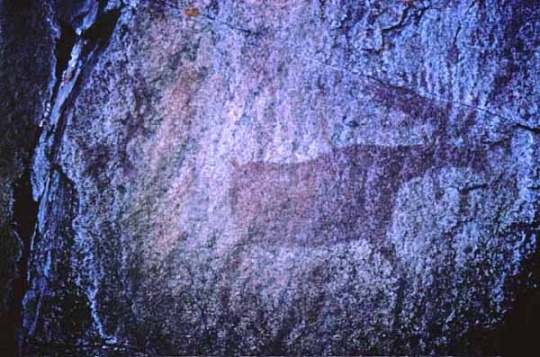
Native American pictographs at Lac La Croix
Holding Location
More Information

Canoe trip
Public domain
Holding Location
More Information
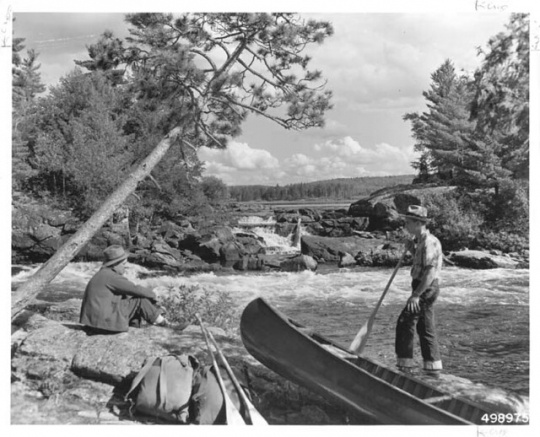
Forest Service workers in the Boundary Waters Canoe Area Wilderness
More Information
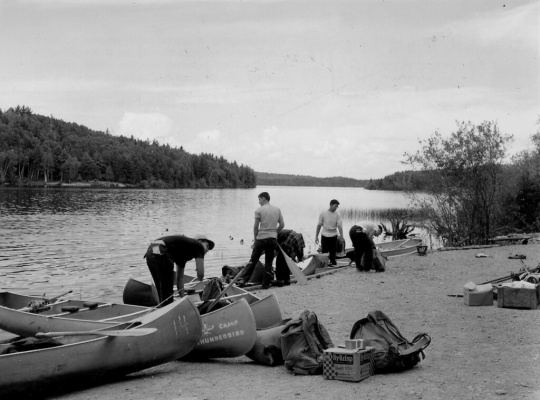
Canoeists at Moose Lake Landing
Holding Location
More Information
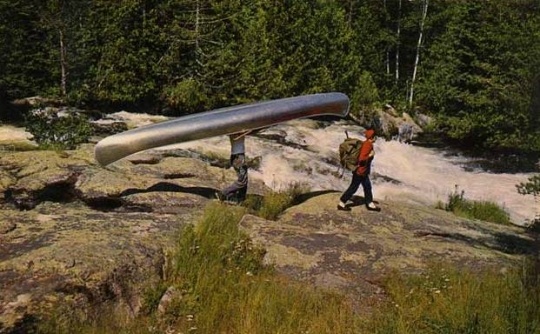
Portaging a canoe in the Boundary Waters
Holding Location
More Information
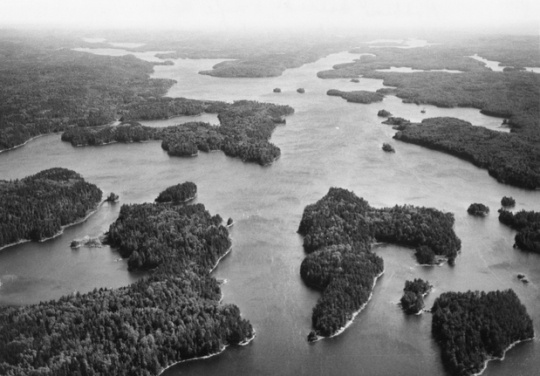
Aerial photo of the Boundary Waters Canoe Area
Holding Location
More Information
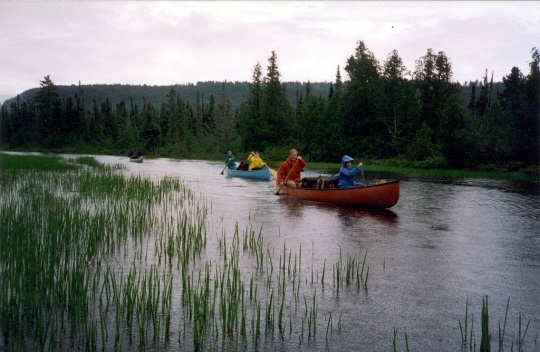
Canoers in the BWCA
Public domain

Pose Lake
More Information
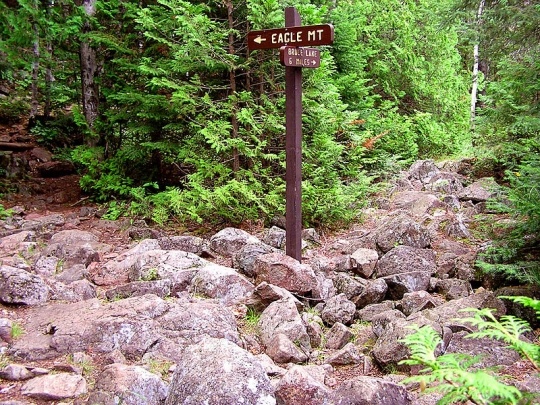
Trail junction
Public domain
Holding Location
More Information
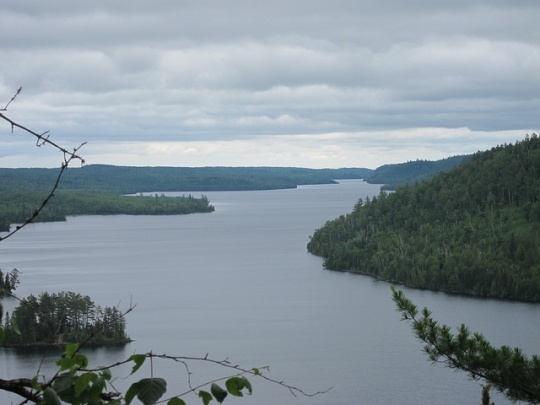
View from the Border Route Trail
Holding Location
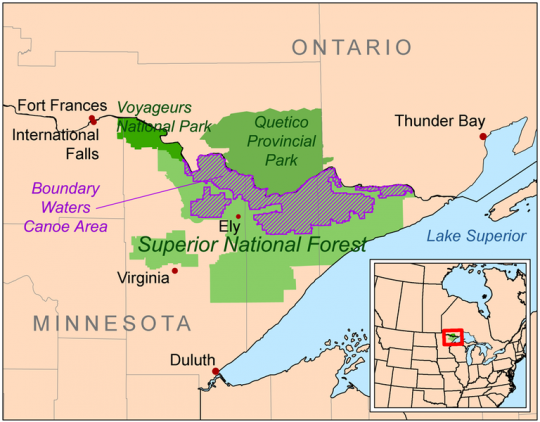
Map showing the location of the Boundary Waters Canoe Area Wilderness
Holding Location
More Information
Related Articles
Turning Point
In 1964, the Boundary Waters Canoe Area becomes part of the National Wilderness Preservation System.
Chronology
1902
1905
1909
1930
1934
1938
1948
1949
1958
1964
1978
2013
2021
Bibliography
Atwood, Burton H. Controversy in the Boundary Waters Canoe Area: A Study. Glenview, IL: Izaak Walton League of America Endowment, 1964.
Backes, David. A Wilderness Within: The Life of Sigurd Olson. Minneapolis: University of Minnesota Press, 1997.
——— . Canoe Country: An Embattled Wilderness. Minocqua, WI: NorthWord Press, 1991.
Chadwick, Phil,et. al.. “The Boundary Waters-Canadian Derecho.” Storm Prediction Center: NOAA/National Weather Service.
http://www.spc.noaa.gov/misc/AbtDerechos/casepages/jul4-51999page.htm
Gladden, James N. The Boundary Waters Canoe Area: Wilderness Values and Motorized Recreation. Ames, IA: Iowa State University Press, 1990.
Helland, John. “Chronology of Historical Actions for Boundary Waters Canoe Area Wilderness within Minnesota’s Superior National Forest.” Minnesota House of Representatives Information Brief, October 2004.
http://www.house.leg.state.mn.us/hrd/pubs/bwcawild.pdf
Hemphill, Stephanie. “Ten Years After Blowdown, Boundary Waters Still Recovering.” MPR News, July 2, 2009.
https://www.mprnews.org/story/2009/07/01/bwca_blowdown_anniversary
History of the Boundary Waters Canoe Area Wilderness. Zenith City History Archives.
Marcotty, Josephine. “Loved and Loathed, Longtime Activist Has Drawn a Line in BWCA.” Minneapolis Star Tribune, November 27, 2016.
http://www.startribune.com/bwca-girl-guide-is-now-a-woman-warrior/403115576/
Parke, Peter S., and Norvan J. Larson. “Boundary Waters Windstorm: The Blowdown of July 4th, 1999.” National Weather Service, undated.
http://www.weather.gov/media/dlh/StormSummaries/Other/19990704/parkelarsonwriteup.pdf
Save the Boundary Waters. About the Campaign.
https://www.savetheboundarywaters.org/about-campaign
United States Department of Agriculture: Forest Service. Boundary Waters Canoe Area Wilderness.
http://www.fs.usda.gov/detail/superior/specialplaces/?cid=stelprdb5202169
United States Department of Agriculture: Forest Service. BWCAW Act.
http://www.fs.usda.gov/detail/superior/specialplaces/?cid=stelprdb5203434
United States Department of Agriculture: Forest Service. Heritage History.
http://www.fs.usda.gov/detail/superior/learning/history-culture/?cid=fsm91_049843
Wilbers, Stephen. A Boundary Waters History: Canoeing Across Time. Charleston, SC: History Press, 2011.
Related Resources
Primary
Administrative subject files, 1900–1978
Minnesota Conservation Department, Division of Forestry
State Archives, Minnesota Historical Society, St. Paul
Description: Subject files documenting the administrative aspects of the division's activities and duties. Some records highlight the Boundary Waters Canoe Area.
http://www2.mnhs.org/library/findaids/cons062.pdf
Boundary Waters Canoe Area Wilderness Act litigation files, 1979–1982
Manuscript Collection, Minnesota Historical Society, St. Paul
Description: Correspondence, legal briefs, and miscellaneous litigation files relating to a lawsuit brought by the State of Minnesota and various landowner associations against the U.S. Government, the Sierra Club, and other environmental groups regarding the 1978 Boundary Waters Canoe Area Wilderness Act.
BWCA Wilderness News. Minneapolis: Friends of the Boundary Waters Wilderness, 1985–2003.
Sigurd F. Olson papers, 1920s–1989
Manuscript Collection, Minnesota Historical Society, St. Paul
Description: This archival collection contains a wide variety of materials related to the literary career and environmental advocacy of Sigurd F. Olson, one of Minnesota's leading outdoor writers and wilderness preservationists. The papers include information on Olson's involvement with various conservation organizations, particularly the National Park Service, the National Parks Association, the President's Quetico-Superior Committee, the Friends of the Wilderness, the Izaak Walton League of America, and the Wilderness Society, as well as his role in issues related to the Superior National Forest and the Boundary Waters Canoe Area.
http://www2.mnhs.org/library/findaids/00316.xml
M211
Superior National Forest Records, 1903–1969 [microform]
Manuscript Collection, Minnesota Historical Society, St. Paul
Description: This archival collection (1903–1969) contains correspondence, reports, maps, clippings, memoranda, and federal bills and documents selected from the files of the Superior National Forest office in Duluth, documenting the forest's expansion, consolidation, management and use policies, and general history. Management files (approximately eight reels of microfilm) concentrate on administration of the "roadless areas" that eventually became the Boundary Waters Canoe Area, including automobile and aircraft trespass, timber cutting, road construction, establishment of primitive and wild areas, water levels, and motorized watercraft. Also included are files on regulation of international boundary waters and relations with adjoining Quetico Provincial Park in Ontario, Canada.
Secondary
Olson, Sigurd F. The Meaning of Wilderness: Essential Articles and Speeches. Minneapolis: University of Minnesota Press, 2001.
Proescholdt, Kevin. Troubled Waters: The Fight for the Boundary Waters Canoe Area Wilderness. St. Cloud, MN: North Star Press of St. Cloud, 1995.













